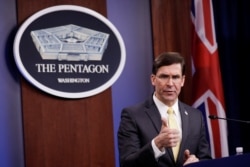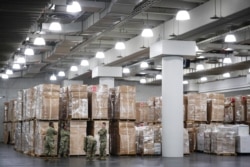The USNS Mercy hospital ship has left its San Diego port for Los Angeles on Monday to help support the city’s response to an overwhelming number of coronavirus cases.
“This is a big day for the Mercy, Navy medicine and our national response to the coronavirus pandemic,” said Capt. John Rotruck, the ship’s commanding officer.
Defense Secretary Mark Esper told reporters Monday at the Pentagon that the Defense Department was working with the Federal Emergency Management Agency (FEMA) to set the conditions for the Mercy’s arrival in L.A. later this week.
The U.S. military’s two hospital ships and other military assets, such as field hospitals, will provide triage and urgent care but will not treat coronavirus patients, because they are not designed with segregated spaces needed to treat infectious diseases.
Instead, the military hospital ships and field hospitals sent to overwhelmed cities will free up local hospital beds and local medical professionals so they can devote more of their resources to isolating and treating those with the highly contagious COVID-19.
Esper said Monday the Mercy will focus on helping “some of L.A.’s most heavily-stressed hospitals.”
Though San Diego and Los Angeles are only about 200 km apart, the ship will take multiple days to get to the Port of Los Angeles because its crew must first perform a number of operational certifications “at sea, underway, prior to any arrival,” according to Navy officials.
Rotruck said the medical professionals on board will use that time for training, with plans to stay in L.A. as long as needed and travel to another overwhelmed city, if tasked.
The Mercy has more than 800 Navy medical personnel and support staff on board, along with more than 70 civil service mariners, according to the Navy.
Key medical staff for the USNS Mercy and USNS Comfort hospital ships reported for duty last Thursday to get the ships ready to deploy.
The Comfort is undergoing maintenance in Norfolk, Virginia, and will deploy to New York Harbor in the coming weeks.
Both ships are preparing for a 1,000-bed mission, the largest mission set these ships can accommodate, U.S. Navy Surgeon General Rear Adm. Bruce Gillingham said last week.
In addition to the hospital ships, Esper said Monday that five of the U.S. military’s expeditionary medical units are on “prepare-to-deploy orders,” and he anticipates the Pentagon will send field hospitals to Seattle and New York City.
Meanwhile, the Army Corps of Engineers is preparing to convert thousands of New York City hotel and dormitory rooms into temporary medical units to help combat COVID-19.
The U.S. Air Force has flown a patient staging system for the Italian Ministry of Defense, capable of supporting 40 patients in a 24-hour period, to Aviano, Italy. On Friday, an Air Force crew flew the U.S. women’s football team home from Honduras after the country closed its borders.
President Donald Trump on Sunday authorized the use of the National Guard under Title 32 status, which means the troops will be federally funded but remain under state control.
“This is not a move toward Marshal Law, as some have erroneously claimed,” Esper said Monday, referencing the president’s legal, yet limited, authority to impose direct military control over what are normally civilian functions in response to an emergency.
More than 8,000 U.S. National Guard personnel are responding to the coronavirus pandemic in all 54 states, territories and the District of Columbia, according to officials. Tasks range from delivering meals to screening symptoms for testing facilities.
“We are in this for the long haul,” National Guard Bureau Chief Gen. Joseph Lengyel said Sunday, while cautioning that the Guard has the supplies needed in the near term but is “concerned about longer-term supplies.”
As of early Monday, 243 coronavirus cases around the globe were related to the U.S. military — 133 service members, 44 civilians, 35 dependents and 31 contractors — the Pentagon said. One U.S. defense contractor in northern Virginia has died from the virus.









